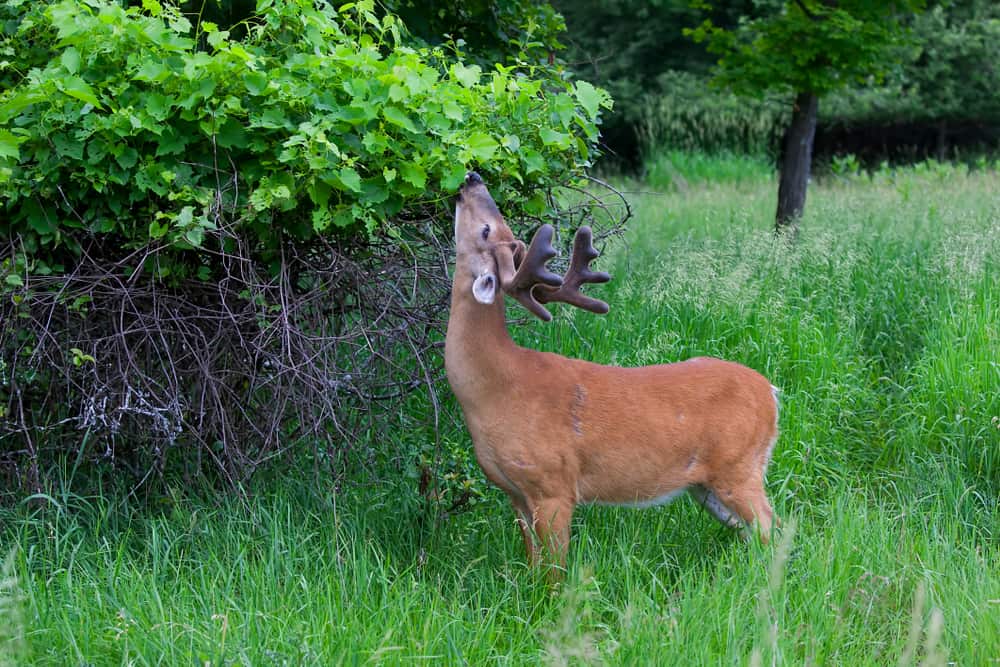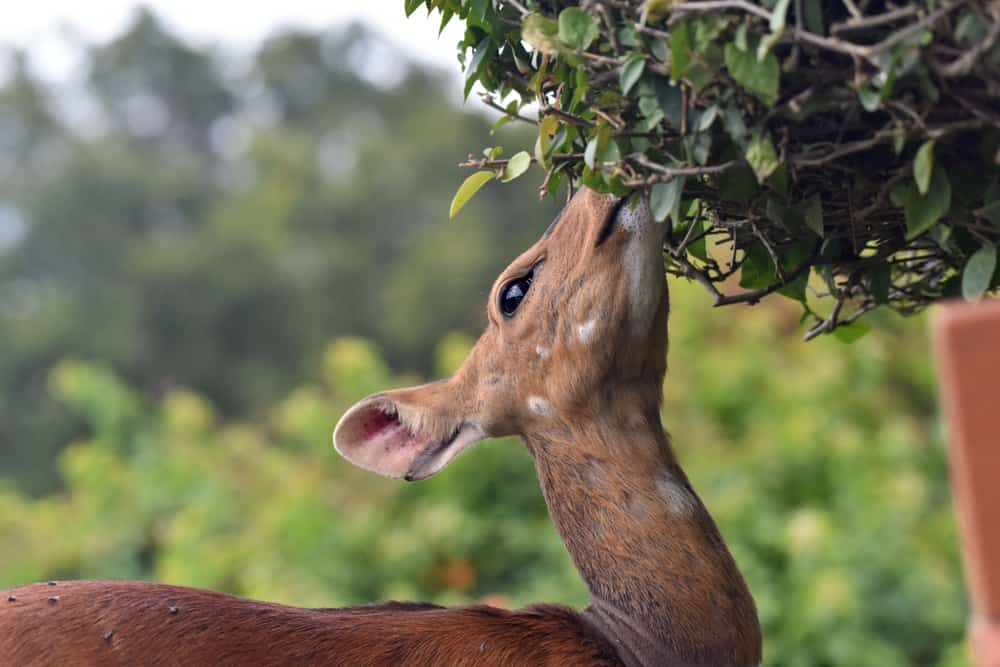What Do Deer Eat for Feed
When you hear the word deer, what's the first thing that crosses your mind? Antlers? Christmas? Rudolph the red-nose reindeer, maybe?
Known commonly for their antlers, deer are hoofed mammals belonging to the family Cervidae. In case you have no idea what deer eat. Buckle up, and let's find out.
Deer Habits And Biology
The deer family consists of two main groups, the Cervinae, and the Capreolinae. The Cervinae mainly consists of the muntjac, the elk/wapiti, the red deer, and the fallow.
The Caprilinae consists of the reindeer/caribou, the white-tailed deer, the vol deer, and the moose.
True deer are very social, and they travel together in herds, often led by the male. Some herds of the caribou species embody up to 100,000 deer.
Though active during the day, deer are known to be most active at sunrise and dusk. They are crepuscular and mainly feed before dawn and for some hours after the sun has risen.
These hooved mammals are also uniquely adapted to their feeding habits. They contain several features that assist them in getting to their foods and extracting nutrients required for their diets.
All ruminants, deer alike, have a dental fomula to suit their feeding habits. They have a total of 32 teeth and a tough pad in place of the upper incisors.
Among other adaptations, deer cheeks have crescent ridges of enamel, enabling them to grind a large variety of vegetation.
White-tailed deer have sharply pointed heads, enabling them to reach plants and select distinct plants and specific plant parts.
Also, these ruminants are equipped with long and slender tongues allowing them to extract succulent stems and leaves when browsing.
In addition to the above, deer have active salivary glands which produce enzymes that help deactivate secondary plant compounds such as tannins that disrupt digestion.
Deer are ruminants, meaning they feed mainly on vegetation. They acquire nutrients by fermenting plant-based foods in a specialized stomach called the rumen. Deer depend on micro-organisms found in the rumen for the fermentation to occur.
Do Deer Eat Dirt?

Yes, they do. There are two main theories behind the reason why deer eat dirt. The first theory is based on nutrients deficiency.
It is said that deer purposely eat soil to recharge mineral deficits. They require the minerals calcium and phosphorous in large amounts to support antler growth.
But in soil, they seek out sodium which is essential in lactation. No. bucks (male deer) don't lactate. Therefore it is crucial to doe (female deer).
The second theory revolves around soil composition. Soil has compounds that battle plant toxins and improve rumen (first stomach) function during the change between seasons and forage—clay specifically aids in belly issues.
What Do Deers Eat Most?
Deers are ruminants, and therefore their diets are limited, mainly to feeding only on vegetation. Their diet primarily comprises woody plants, grasses, foliage, flowers, shrubs, and fruits.
Having specialized stomachs and requiring high nutrition, they select easily digestible foods. Deer are also known as 'concentrate grazers.' Examples of food deer eat are:
- Soybeans –are very rich in nutrients and contain up to 40% protein crucial in the diets of deer.
- Grass –compromise less than 10% of a deers diet. It also contains protein. Tough in low amounts.
- Chestnuts –are high in protein and carbohydrates. They are also low in tannins that inhibit digestion.
- Mushrooms –are high in phosphorous and proteins that aid in the growth and development of deer muscles.
- Forbs –are highly digestible and are a rich source of energy, vitamins, and antioxidants.
- Beechnuts –are high in proteins and fats crucial for energy and maintaining body mass in deers.
- Twigs
- Alfalfa –contain protein in small amounts and provide a good supplement for the nutrition of deer.
- Apples and peaches –are palatable for deer and are high in fiber that aid in the digestion of other foods.
- Acorns –are rich in protein, carbohydrates, fats, and minerals such as potassium, phosphorous, and calcium. They also contain vitamin C, all of which play a big part I the survival of deer.
- Bark –cedar elm, four-wing, and saltbush
- Shoots
- Pecans –are fed on commonly during winter and are high in fat, providing sufficient energy to carry the deer throughout the winter season.
- Hickory –aren't very effective to the diets of deer but are fed on as deer find them tasty.
- Persimmons –are also known as deer candy due to their appealing taste and are high in nutrients; starch, vitamin C, potassium, iron, phosphorous, iron, and carbohydrates.
- Foliage
- Wild crabapple –though bitter, they contain tannins and have a high nutrition value as well.
- Clover leaves –are a preferred source of food during the winter season, especially the red clovers, which are high in nutrients crucial to the deer diet.
- Old Man's Beard –grey lichen, typically found growing on dead spruce and balsam trees high in nutrients and essential in deers diet.
- Weeds –dandelions, ragweed, and asters
- Trees –willow, oak and, red cedar are fed on, especially in the winter season. They act as good supplements for deer feed.
- Oat –are easily digestible and are rich in crude protein to aid in muscle development in deer.
- Staghorn sumac (a plant) –provides a sufficient amount of nutrients during the winter season. Deer feed on their fruits to supplement their diets.
Deer diets usually vary during the seasons. Hence they are prone to gradually changing their diets from time to time.
Deers on the island of Rum consume meat when it's available, even though they mainly feed on vegetation.
Foods Avoid to Feed Deers

Like every other animal, deer also have foods they distaste or are toxic to their health. These food substances may be harmful to them. Some cause a variety of illnesses, and others may even lead to death.
Some of the food substances you should avoid feeding deers include:
- Potatoes –are deer-resistant plants, and therefore deer will avoid eating them.
- Kitchen scraps –These are carrot pulp, fruit peeling, or herb stems. Deer lack the bacteria required to digest these foods. They will die of hunger.
- Hay –during winter, deers are in browsing mode; hence they lack the correct bacteria in their digestive tracts to digest hay. Ultimately, this will lead them to die of starvation regardless of feeding on the hay.
- Grapes and raisins –have high sugar contents that may prove harmful to deer during the winter season.
- Wild mushrooms –are poisonous to deer and may be deadly to the animals if ingested.
- Corn –due to its capability to ferment quickly, corn may cause problems to the digestive system of deers.
- Tomatoes –are part of the nightshade family, many of which can be poisonous to deer.
- Tomato leaves- apart from the fruits, the fruit of the tomato plants are also toxic to these hoofed animals.
- Rhubarbs –These plants are a part of the nightshade family. They contain oxalic acids. When ingested in large amounts, they cause gastrointestinal problems, kidney stones, and even kidney failure.
- Eggplants –are a part of the nightshade family, which are toxic to deer and other ruminants.
- Cucumbers –may seem healthy but are also among the nightshade family that harms deers.
- Rosemary –contains volatile oils, which cause stomach upsets and even depression in these ruminants.
- Onions –are members of the allium family, which results in complications such as anemia to deers.
- Chives – are part of the allium family. They cause the blood cells of the ruminants to rapture, in the long run, leading to anemia,
- Carrots –are edible, yes, but only the tip and the stem. Roots of carrots can prove harmful if eaten.
- Garlic –causes anemia in deers of all species.
It is vital to avoid feeding deers these harmful food substances listed above for them to thrive.
Tips To Feeding Deers
Are you interested in feeding deers? It would be best to keep in mind that suddenly introducing new foods to deer is not advised. Introduction of supplementary food should be done gradually.
The environment, knowing when to feed the deer, and their diets should also be kept in mind. So, what are the best ways to feed deer?
- When feeding these browsers, especially during winter, introduce a new diet. It takes a few for them to adjust to a new diet. Begin feeding them gradually.
- Present new types of food to the deers' diet aid their digestive systems to learn to process them. It would help if you did this before winter.
- Purchase formulated deer mix. These feeds are usually a mix of oats, alfalfa, molasses, soybeans, and other vitamins and minerals. The ruminants effortlessly digest them.
- If the formulated deer mix is unavailable, ensure you feed the deers foods right for them. The best supplement for deers is oats.
- Oats provide a combination of fibers and carbohydrates, and they don't interfere with the deers' digestive system.
- Veggies such as cherries, grapes, pears, carrots, and apples act as good supplements. Another good source of supplements is acorns.
- Avoid feeding deers a corn diet. The ruminants may be unable to adjust to the high carbohydrate diet and may ultimately lead to death.
- You can also provide them with more of their natural food source. Cut down tree branches out of their reach and feed them.
- Knowing when to feed deer is vital, enabling you to plan yourself. Feeding should be done during winter.
- Supplemental food should be offered all year round.
- As winter comes to an end, slowly wean the deer of the supplementary food.
Following these simple steps will help you help these creatures in the long run.
Summary
Don't be fooled when you spot a deer out in a field full of pasture grazing on land. Deer are not your regular ruminants that slowly graze on grass. They are fast eaters. If you're lucky, you might spot one changing color in winter—behold, what classy creatures.
Source: https://www.atshq.org/what-does-deer-eat/
0 Response to "What Do Deer Eat for Feed"
Post a Comment